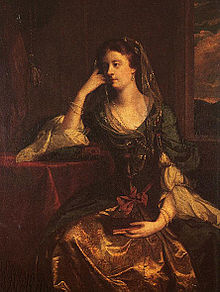Emily FitzGerald, Duchess of Leinster
| Emily FitzGerald | |
|---|---|

The Duchess of Leinster. 1753 portrait by Sir Joshua Reynolds.
|
|
| Born | Lady Emilia Mary Lennox 6 October 1731 |
| Died | 27 March 1814 (aged 82) Grosvenor Square, London |
| Nationality | British |
| Title | Duchess of Leinster Marchioness of Kildare Countess of Kildare |
| Spouse(s) |
James FitzGerald, 1st Duke of Leinster William Ogilvie |
| Children |
William FitzGerald, 2nd Duke of Leinster Mary Coote, Countess of Bellamont Charles FitzGerald, 1st Baron Lecale Charlotte Strutt, 1st Baroness Rayleigh Lord Henry FitzGerald Lady Sophia FitzGerald Lord Edward FitzGerald Lord Robert FitzGerald Lord Gerald FitzGerald Lady Lucy Foley Cecilia Lock Emily Beauclerk |
| Parent(s) |
Charles Lennox, 2nd Duke of Richmond Sarah Cadogan |
Emily FitzGerald, Duchess of Leinster (6 October 1731 – 27 March 1814), known before 1747 as Lady Emily Lennox, from 1747 to 1761 as The Countess of Kildare and from 1761 to 1766 as The Marchioness of Kildare, was the second of the famous Lennox sisters, daughters of Charles Lennox, 2nd Duke of Richmond, and illegitimately descended from King Charles II of England.
Lady Emily married James FitzGerald, 20th Earl of Kildare, on 7 February 1747. After their wedding in London, the couple returned to Fitzgerald's native Ireland, first residing at Leinster House then Carton House.
Their marriage was reportedly a happy one, despite Lord Kildare's infidelities. The couple had nineteen children:
Lord Kildare was created successively Marquess of Kildare and Duke of Leinster in recognition of his contribution to the political life of his country. It was partly the Duke's influence that led to a rift between the Duchess and her eldest sister, Caroline Fox, 1st Baroness Holland.
After the death of Lord Kildare in 1773, the Duchess caused a minor sensation by marrying (26 August 1774) her children's tutor, William Ogilvie, with whom she had begun an affair some years earlier in Frescati House. Despite her remarriage she continued to be known as The Dowager Duchess of Leinster. Ogilvie was nine years her junior, and was the natural father of her youngest son from her first marriage. They lived for part of their marriage at Ardglass Castle in Ardglass, County Down, where Ogilvie worked to develop the village. A further three children were born to them after their marriage:
Emily was treated generously in her first husband's will. He left her a jointure of 4,000 pounds annually (increased from the 3,000 promised in the settlement), and a life interest in Leinster House (Dublin) and Carton (which she exchanged for Frescati House and 40,000 pounds) together with all their contents. She had brought the usual ducal daughter's dowry of 10,000 pounds, so the jointure and other payments would cripple her son the 2nd Duke of Leinster financially. The 1st Duke also made over-generous provisions for his younger sons and all his daughters. Emily, Duchess of Leinster and her second husband, also received the usual annuity of 400 pounds annually for each of the minor children who lived with her. Thus, Emily and William Ogilvie were probably financially better off than the 2nd Duke, who existed on less than 7,000 pounds annually out of which he had to run two large houses, play a role in Irish politics, and also provide lavish dowries of 10,000 each for three sisters who married. He also had to pay huge annuities (2,000 each) to the next youngest brothers Lord Lecale and Lord Henry Fitzgerald, and to pay the youngest brothers 10,000 each at their majority. Since Emily lived to 1814 (outliving the 2nd Duke by ten years), all these generous testamentary provisions, along with the huge building costs incurred by the 1st Duke, crippled the Leinsters for generations.
...
Wikipedia
